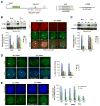YY1 tethers Xist RNA to the inactive X nucleation center
- PMID: 21729784
- PMCID: PMC3150513
- DOI: 10.1016/j.cell.2011.06.026
YY1 tethers Xist RNA to the inactive X nucleation center
Abstract
The long noncoding Xist RNA inactivates one X chromosome in the female mammal. Current models posit that Xist induces silencing as it spreads along X and recruits Polycomb complexes. However, the mechanisms for Xist loading and spreading are currently unknown. Here, we define the nucleation center for Xist RNA and show that YY1 docks Xist particles onto the X chromosome. YY1 is a "bivalent" protein, capable of binding both RNA and DNA through different sequence motifs. Xist's exclusive attachment to the inactive X is determined by an epigenetically regulated trio of YY1 sites as well as allelic origin. Specific YY1-to-RNA and YY1-to-DNA contacts are required to load Xist particles onto X. YY1 interacts with Xist RNA through Repeat C. We propose that YY1 acts as adaptor between regulatory RNA and chromatin targets.
Copyright © 2011 Elsevier Inc. All rights reserved.
Figures







Comment in
-
A YY1 bridge for X inactivation.Cell. 2011 Jul 8;146(1):11-3. doi: 10.1016/j.cell.2011.06.029. Cell. 2011. PMID: 21729777
References
-
- Brockdorff N, Ashworth A, Kay GF, McCabe VM, Norris DP, Cooper PJ, Swift S, Rastan S. The product of the mouse Xist gene is a 15 kb inactive X-specific transcript containing no conserved ORF and located in the nucleus. Cell. 1992;71:515–526. - PubMed
-
- Brown CJ, Hendrich BD, Rupert JL, Lafreniere RG, Xing Y, Lawrence J, Willard HF. The human XIST gene: analysis of a 17 kb inactive X-specific RNA that contains conserved repeats and is highly localized within the nucleus. Cell. 1992;71:527–542. - PubMed
Publication types
MeSH terms
Substances
Grants and funding
LinkOut - more resources
Full Text Sources
Other Literature Sources
Molecular Biology Databases

